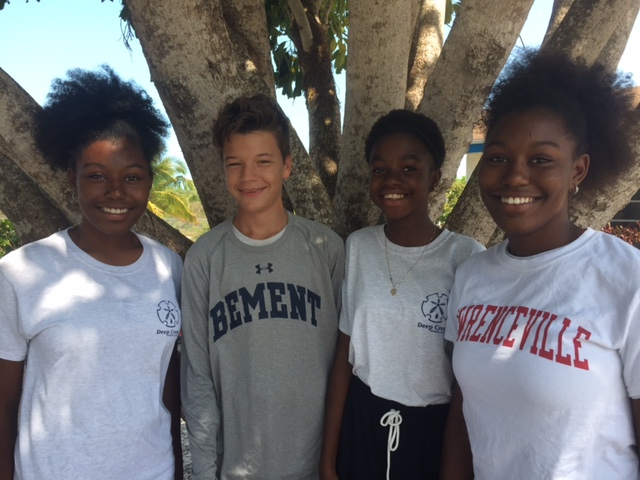Over the past few weeks, the CEI reef team has gone on three night dives in search of the nocturnal West Indian spider crab (Mithrax spinosissimus). At the start of February the team of research technicians and interns headed out to their first dive site, known as Cathedral, just a few hundred meters off the south-west coast of the Cape. They observed a variety of nocturnal creatures, like huge spiny lobster (Panularis argus) and mantis shrimp (Odontodactylus scyallarus), but unfortunately no crabs. After nearly 40 minutes of searching they abandoned the dive, hopped back on the boat and drove a few minutes north to the next site, Tunnel Rock. The team navigated the large rocks and surrounding reefs for another 40 minutes and saw lots of exciting animals, such as a porcupinefish (Diodon holocanthus) and a green turtle (Chelonia mydas), but still no sign of the elusive spider crab.
The following evening the team decided to try again in a different location, journeying north of the CEI campus to the patch reefs. The interns snorkeled out to examine the first reef from the surface, and were excited to find several huge crabs foraging on the reef below. The team quickly pulled on their SCUBA equipment and descended the 3 or 4 meters to the sea floor. They were shocked when they saw the huge crabs up-close, they knew that spider crabs are the biggest crabs in the Caribbean, but were still not prepared to come face to face with a crab over 1 foot across.
It has been several years since a captive crab study has been carried out at CEI and, without an experienced crab catcher, the team weren’t sure how difficult the crabs would be to handle. Nevertheless, intern Daisy Buzzoni approached the closest spider crab nestled under a ledge of the reef. She positioned her handheld nets around the crab and gradually inched them towards each other. The crab sprang into action and scurried quickly to its left, straight into one of the nets! Using the same technique, the team moved between the small patch reefs and managed to catch 5 more sizeable crabs. Over the past few weeks, the reef team has been on more crab catching expeditions and has caught over 30 of them!
Reef team intern, Daisy Buzzoni, proudly holding the huge spider crabs she caught from the patch reefs using handheld nets. These crabs were transported back to our wet lab in a tank full of saltwater on the boat.
Over the next few months, the diet and behavior of these crabs will be studied by a visiting scientist, Dr. Iain McGaw, to assess how crabs could be used to control algae build up in aquaculture operations. Most systems currently use power washing or chemicals to remove the accumulations of algae, which have been shown to pollute the surrounding environment. Iain hopes that crabs could provide a more ecologically friendly and sustainable method of maintaining productive aquaculture systems.
This spider crab has made itself at home in a piece of PVC tubing in one of our wet lab tanks. We put these tubes in the tanks to provide the crabs with a habitat similar to the ledges and holes they would shelter under on the reefs.
The crabs collected by the reef team are quite settled into their new home and thriving in the saltwater tanks in our wet lab. They will stay here for several weeks, whilst Iain assesses what species of algae is favored by these crabs and what time of day they are engaging in the most foraging behavior. These crabs will also be studied by Logan Zeinert, a research technician for the reef team. After studying them in the wet lab, Logan will move the crabs to a large algae encrusted structure just off the coast of the Cape. This site, known locally as “The Cage”, was previously used to house Cobia as part of an old CEI aquaculture project, but since it’s decommission, has accumulated a thick layer of algae. Once moved here, Logan will monitor the crabs and their consumption of this algae to calculate the efficiency of their feeding.
Keep checking our Blog and Facebook page to stay up to date with news from the reef team and all the other projects at CEI.
